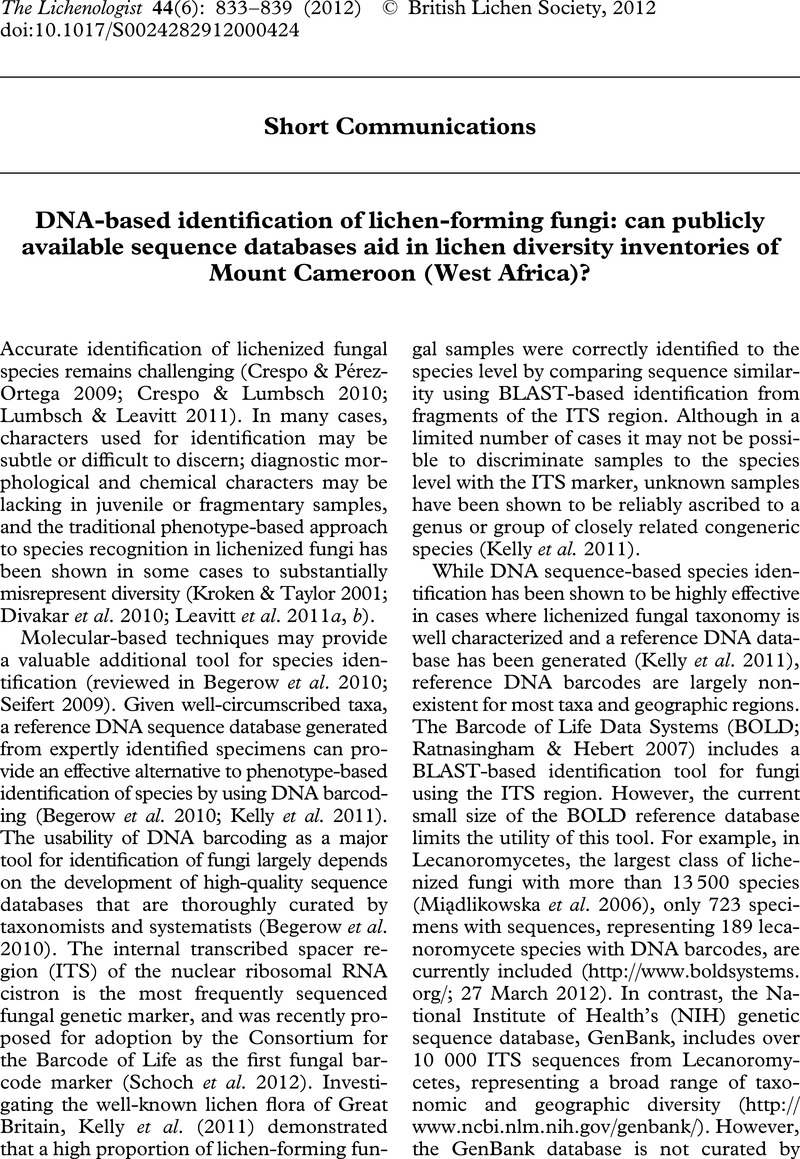Crossref Citations
This article has been cited by the following publications. This list is generated based on data provided by Crossref.
Hodkinson, Brendan P.
and
Hodkinson, Sarah Z.
2013.
Recent literature on lichens—228.
The Bryologist,
Vol. 116,
Issue. 1,
p.
89.
Kondratyuk, S.
Lőkös, L.
Kim, J.
Jeong, M.-H.
Kondratiuk, A.
Oh, S.-O.
and
Hur, J.-S.
2014.
Kashiwadiagen. nov. (Physciaceae, lichen-forming Ascomycota), proved by phylogenetic analysis of the Eastern Asian Physciaceae.
Acta Botanica Hungarica,
Vol. 56,
Issue. 3-4,
p.
369.
Leavitt, Steven D.
Esslinger, Theodore L.
Hansen, Eric Steen
Divakar, Pradeep K.
Crespo, Ana
Loomis, Bradley F.
and
Lumbsch, H. Thorsten
2014.
DNA barcoding of brown Parmeliae (Parmeliaceae) species: a molecular approach for accurate specimen identification, emphasizing species in Greenland.
Organisms Diversity & Evolution,
Vol. 14,
Issue. 1,
p.
11.
Kondratyuk, S. Y.
Lőkös, L.
Kapetz, N. V.
Pleskach, L. Ya.
Kim, J.
Kondratiuk, A. S.
and
Hur, J.-S.
2015.
Physcia ucrainica sp. nova (Physciaceae, Ascomycota) from the Crimean Peninsula, proved by Molecular phylogeny.
Acta Botanica Hungarica,
Vol. 57,
Issue. 1-2,
p.
143.
Leavitt, Steven D.
Moreau, Corrie S.
and
Thorsten Lumbsch, H.
2015.
Recent Advances in Lichenology.
p.
11.
Masson, Didier
Benatti, Michel N.
and
Sérusiaux, Emmanuël
2015.
The description of a new species reveals underestimated diversity in the lichen genusBulbothrix(Parmeliaceae) in Africa.
The Lichenologist,
Vol. 47,
Issue. 5,
p.
323.
Zúñiga, Catalina
Leiva, Diego
Ramírez-Fernández, Lía
Carú, Margarita
Yahr, Rebecca
and
Orlando, Julieta
2015.
Phylogenetic Diversity of <i>Peltigera</i> Cyanolichens and Their Photobionts in Southern Chile and Antarctica.
Microbes and environments,
Vol. 30,
Issue. 2,
p.
172.
Yahr, Rebecca
Schoch, Conrad L.
and
Dentinger, Bryn T. M.
2016.
Scaling up discovery of hidden diversity in fungi: impacts of barcoding approaches.
Philosophical Transactions of the Royal Society B: Biological Sciences,
Vol. 371,
Issue. 1702,
p.
20150336.
Mark, Kristiina
Cornejo, Carolina
Keller, Christine
Flück, Daniela
Scheidegger, Christoph
and
Xu, Jianping
2016.
Barcoding lichen-forming fungi using 454 pyrosequencing is challenged by artifactual and biological sequence variation.
Genome,
Vol. 59,
Issue. 9,
p.
685.
Temu, Stella G.
Clerc, Philippe
Tibell, Leif
Tibuhwa, Donatha D.
and
Tibell, Sanja
2019.
Phylogeny of the subgenusEumitriain Tanzania.
Mycology,
Vol. 10,
Issue. 4,
p.
250.
Gueidan, Cécile
Elix, John A.
McCarthy, Patrick M.
Roux, Claude
Mallen-Cooper, Max
and
Kantvilas, Gintaras
2019.
PacBio amplicon sequencing for metabarcoding of mixed DNA samples from lichen herbarium specimens.
MycoKeys,
Vol. 53,
Issue. ,
p.
73.
Wright, Benjamin
St. Clair, Larry L.
and
Leavitt, Steven D.
2019.
Is targeted community DNA metabarcoding suitable for biodiversity inventories of lichen-forming fungi?.
Ecological Indicators,
Vol. 98,
Issue. ,
p.
812.
Bate, Petuel Ndip Ndip
Orock, Ayuk Elizabeth
Nyongbela, Kennedy Dohjinga
Babiaka, Smith Borakaeyabe
Kukwah, Anthony
and
Ngemenya, Moses N.
2020.
In vitro activity against multi-drug resistant bacteria and cytotoxicity of lichens collected from Mount Cameroon.
Journal of King Saud University - Science,
Vol. 32,
Issue. 1,
p.
614.
Lücking, Robert
2021.
Peter D. Crittenden: meta-analysis of an exceptional two-decade tenure as senior editor of The Lichenologist, the flagship journal of lichenology.
The Lichenologist,
Vol. 53,
Issue. 1,
p.
3.
Clair, Larry L. St.
Leavitt, Steven D.
Clair, Samuel B. St.
Newberry, Clayton C.
and
Rosentreter, Roger
2021.
Lichen Checklist for the Jarbidge Wilderness Area and Adjacent Forest Service Lands in Northeastern Nevada, USA.
Evansia,
Vol. 38,
Issue. 2,
Orock, A. E.
and
Fonge, B. A.
2022.
Diversity of lichens at Mount Cameroon, South West Region, Cameroon.
International Journal of Biodiversity and Conservation,
Vol. 14,
Issue. 2,
p.
72.
Gueidan, Cécile
and
Li, Lan
2022.
A long-read amplicon approach to scaling up the metabarcoding of lichen herbarium specimens.
MycoKeys,
Vol. 86,
Issue. ,
p.
195.
Munger, Isaac A.
Baugh, Mikele
Henrie, Jacob R.
Hollinger, Jason
Crepeau, Robin
and
Leavitt, Steven D.
2022.
Integrative Biodiversity Inventories: Characterizing Lichen-Forming Fungal Diversity in Glen Canyon National Recreation Area Using DNA Barcoding and Vouchered Specimens.
Western North American Naturalist,
Vol. 82,
Issue. 2,
Simon, Antoine
Goffinet, Bernard
Wang, Li‐Song
Spribille, Toby
Goward, Trevor
Pystina, Tatiana
Semenova, Natalia
Stepanov, Nikolay V.
Moncada, Bibiana
Lücking, Robert
Magain, Nicolas
and
Sérusiaux, Emmanuël
2022.
Global phylogeny and taxonomic reassessment of the lichen genus Dendriscosticta (Ascomycota: Peltigerales).
TAXON,
Vol. 71,
Issue. 2,
p.
256.
La Torre, Renato Daniel
Ramos, Daniel
Mejía, Mayra Doris
Neyra, Edgar
Loarte, Edwin
and
Orjeda, Gisella
2023.
Survey of Lichenized Fungi DNA Barcodes on King George Island (Antarctica): An Aid to Species Discovery.
Journal of Fungi,
Vol. 9,
Issue. 5,
p.
552.



